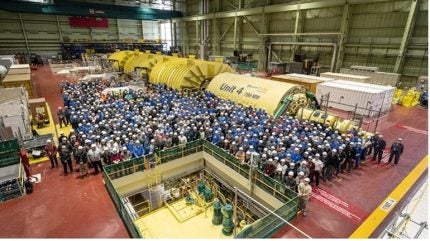
Canada’s Bruce Power have closed unit 4 to begin Major Component Replacement (MCR) as part of its ongoing Life-Extension Programme. The unit 4 outage represents the mid-point of the MCR Project that will see units 3-8 refurbished.
The MCR project began in January 2020. The eight pressurised heavy-water Candu reactor units at the Bruce site in Ontario (Bruce A – units 1-4, and Bruce B – units 4-8) began commercial operation between 1977 and 1987. Bruce Power’s CAD13bn ($10bn) Life Extension Programme, which includes Asset Management and MCR, began in 2016. MCR, which began with unit 6 and also includes units 3-8, will extend the life of the site until 2064. Units 1&2 have already been refurbished and were returned to service in 2012. Work began on unit 3 in March 2023. Unit 6 was taken offline for the refurbishment in January 2020 and was returned to service in 2023. The Life-Extension Programme and MCR Projects will extend the operational life of each reactor by 30-35 years.
“Our Life-Extension Programme and Major Component Replacement is more than a construction project,” said Eric Chassard, Bruce Power President & CEO. “By completing each of the MCR outages safely, on plan, and to a high-quality standard, we are securing the future of the Bruce site, sustaining our communities, and powering Ontario through a time when electricity demand is growing rapidly.”
The Unit 3 MCR, which began in March of 2023, continues to progress on plan and on schedule with a return-to-service date for the renewed unit planned for 2026. Overlapping MCR outages will continue on the Bruce site until 2033, including a magnitude of work on that no other utility in the world has faced.
Bruce Power’s CAD13bn ($9 bn) refurbishment is Canada’s third largest infrastructure project (behind British Columbia’s Peace River Site C hydroelectric project, and Ontario’s Go transit expansion), and is Ontario’s largest clean-energy infrastructure project. Bruce Power’s Life Extension is unique in that it’s being funded through private investment.
Innovative new tooling implemented in the unit 3 MCR outage, including the first robotic tooling used on a reactor face anywhere in the world, has ensured the tradespeople can return the units to service safely, successfully and on schedule. The Ontario Independent Electricity System Operator (IESO) 2025 demand forecast predicts electricity demand could increase by 75% by 2050.
“Under our contract with the IESO, subsequent MCRs are expected to improve on cost and schedule by building on lessons learned and experience,” said Rob Hoare, Vice-President, MCR Execution. “And we’re seeing that happen in real time on this project. Evolutions that were recently completed on unit 3 have been assessed and improved on for execution in unit 4. It’s a testament to the world-class team we have and their commitment to continuous learning, proficiency and excellence.”
Bruce Power currently produces 6,550 megawatts (MW) of peak clean energy and that output will increase to more than 7,000 MW in the 2030s, following the completion of the MCR programme and other Life-Extension projects. The programme and ongoing site operations create and sustain 22,000 direct and indirect jobs annually.






